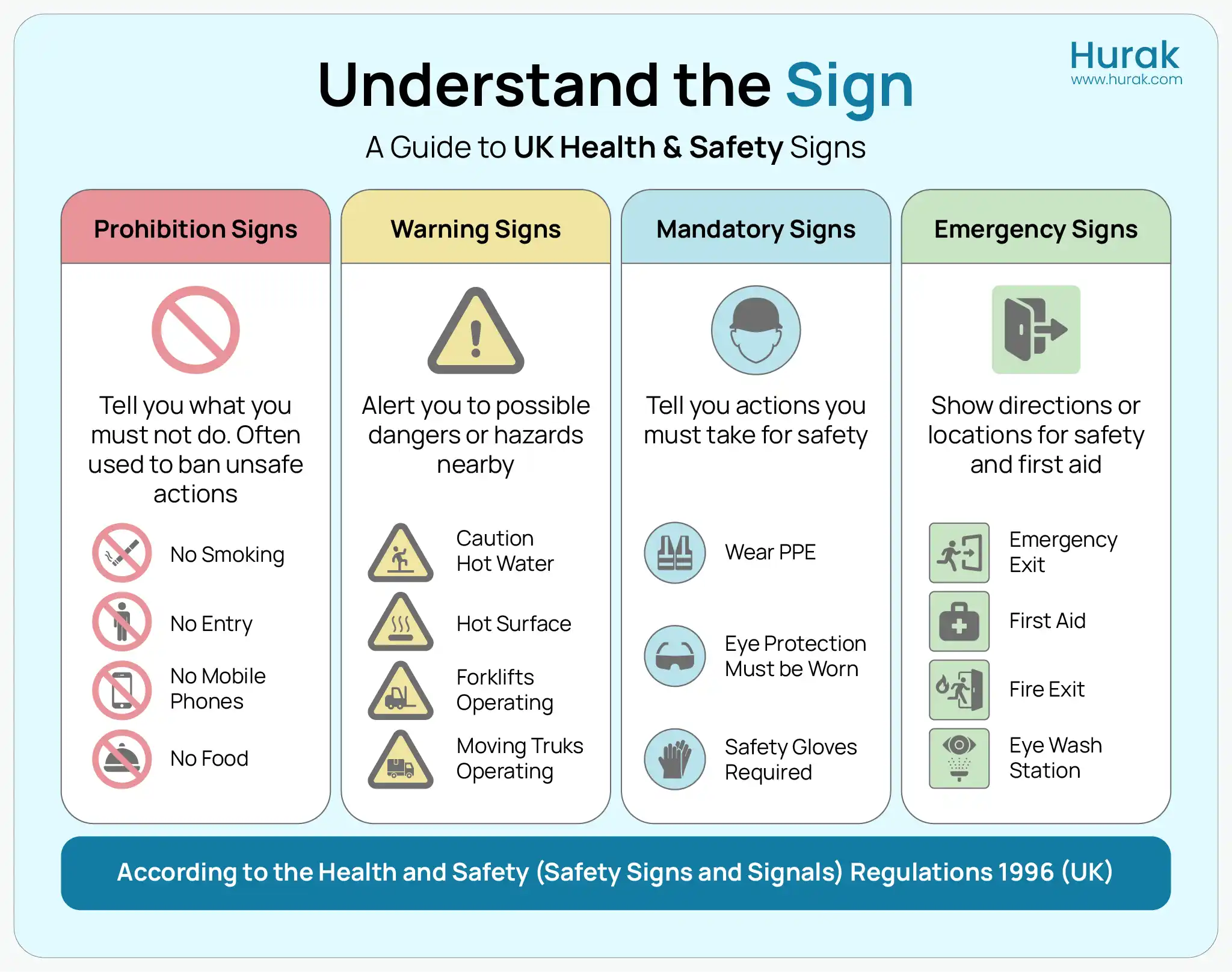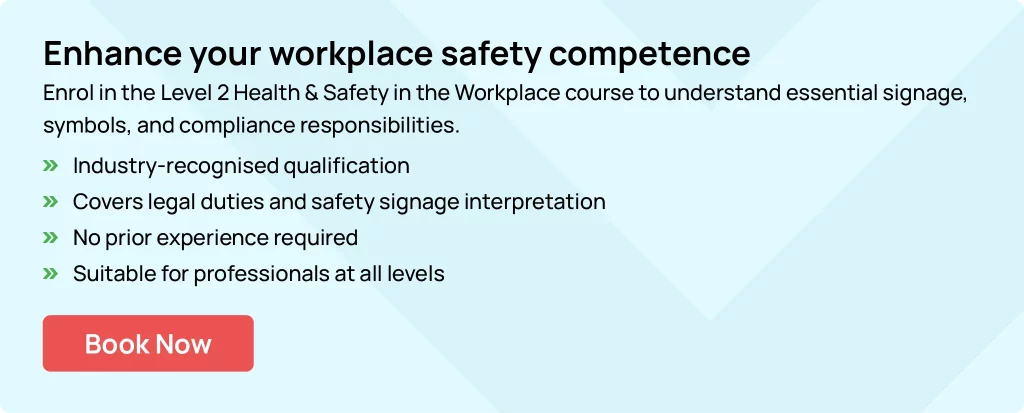
Health and safety signs are a part of everyday life, but in the workplace, they hold special importance. These signs are more than just symbols on walls or equipment; they’re a legal requirement, a safety tool, and in many cases, a life-saving measure. Whether you’re just starting out in your career or managing teams in high-risk industries, understanding what these signs mean and why they matter can make a real difference.
From reminding workers to wear protective equipment to showing emergency exit routes, safety signs play a vital role in keeping people safe and operations compliant. But while they’re often overlooked, being able to recognise and respond to them is a skill every working adult should have.
What Are Health and Safety Signs?
Health and safety signs are visual indicators used to provide important messages about hazards, instructions, or safety procedures in a workplace. Their purpose is to help people avoid accidents, follow rules, and react correctly in emergency situations. These signs are standardised in the UK, which means the colours, shapes, and meanings are consistent across industries and work environments.
For example, a yellow triangle always signals a warning, while a blue circle usually indicates something you must do, like wearing a hard hat. This consistency allows both experienced professionals and newcomers to understand the message quickly, even in high-pressure situations.
Signs are required where there are risks that can’t be completely removed, such as moving machinery, fire hazards, or dangerous substances. In these cases, signs serve as a critical last line of communication to ensure people are aware and prepared.
Why Signs Are More Than Just Visuals
Although health and safety signs are designed to be easily recognisable, their effectiveness depends on how well people understand and act on them. A warning sign near a chemical cabinet, for instance, is only helpful if staff know the dangers involved and follow proper handling procedures. That’s why safety signs are often supported by training, supervision, and risk assessments.
This is especially important in environments like construction sites or industrial facilities, where fast decisions can prevent serious accidents. Understanding signage helps workers respond calmly and correctly to hazards, which protects not only themselves but everyone around them.
If you work in or plan to enter sectors where safety is a priority, like construction, manufacturing, logistics, or facilities management, being familiar with workplace signage is both a legal and professional expectation.
The Law Behind Safety Signage
In the UK, the use of safety signs is governed by the Health and Safety (Safety Signs and Signals) Regulations 1996. These regulations require employers to use safety signs wherever risks remain after other control measures are in place. The law is enforced by the Health and Safety Executive (HSE), which also provides guidance on how to use signs effectively.
It’s not enough for an employer to simply hang a sign on a wall. The law requires that the sign be:
- Clearly visible
- Maintained in good condition
- Supported with training so that employees understand what it means
For employees, understanding the message of a sign is a basic legal responsibility. Failing to do so can lead to injury, disciplinary action, or even legal consequences in severe cases.
Understanding the Colours and Shapes of Signs
To make safety messages as clear as possible, UK regulations define five main types of signs based on colour and shape. This standardisation means people can quickly identify the type of information a sign is communicating, even from a distance.
- Red signs (often circular) indicate prohibited actions or mark fire equipment (e.g. No Smoking, Fire Extinguisher).
- Yellow signs (triangular) are warnings, alerting people to potential hazards (e.g. Caution: Wet Floor).
- Blue signs (circular) are mandatory, telling people what they must do (e.g. Wear Safety Boots).
- Green signs (square or rectangular) provide emergency information, like escape routes or first aid stations (e.g. Emergency Exit).
🔥Be prepared to lead in an emergency.
Learn how to respond to fire safety signs and carry out fire procedures with confidence.
Become a certified Fire Marshal

When and Where These Signs Are Used
You’ll find safety signs in almost every workplace, but especially in environments where risks are more likely. Construction sites, warehouses, kitchens, hospitals, workshops, and chemical labs all rely on signage to protect workers and visitors.
Let’s take a construction site as an example. Signs such as No Entry, High Visibility Clothing Must Be Worn, and Danger: Overhead Work are not just suggestions; they’re mandatory precautions that workers must follow. Failing to recognise or obey these signs can lead to serious injury.
If you’re in a supervisory role or aiming for one, learning how these signs fit into daily operations and site rules is a crucial part of your responsibility. Courses like SSSTS (Site Supervisor Safety Training Scheme) or SMSTS (Site Management Safety Training Scheme) include training on how to implement and monitor signage use effectively.
Why Professionals and Job Seekers Should Care
While signs are there to protect everyone, understanding them also demonstrates professionalism. Employers value staff who take safety seriously. Knowing what different signs mean and responding to them correctly shows you’re not just aware, you’re responsible, alert, and a team player.
For job seekers, especially those entering industries where safety is heavily regulated, basic knowledge of safety signage is often expected. It may be part of your induction training, and in some cases, required before you can even enter certain areas of a site.
Understanding signage also boosts confidence. You’ll know how to navigate unfamiliar spaces, identify risks on your own, and act without waiting for instructions. In the long run, this makes you a safer, more reliable member of any team.
🚧Step into site leadership with confidence.
Understand how safety signage fits into your legal duties as a site supervisor.
Join the SSSTS course
Signs Alone Aren’t Enough – Training Matters
While safety signs do a great job of communicating risks visually, they work best when supported by proper training. A No Entry sign might prevent someone from walking into a dangerous area, but unless they know what’s behind the door or why it’s dangerous, they may not treat the sign seriously.
Similarly, a sign that says Caution: Manual Handling Risk is only useful if workers understand how to lift properly and avoid injury. If you want to understand the connection between signage and physical safety, it’s worth exploring how to avoid manual handling risks.
In some workplaces, safety signs also work hand in hand with broader safety strategies, including fire drills, PPE policies, and COSHH (Control of Substances Hazardous to Health) procedures.
A Practical First Step: Basic Safety Training
For professionals looking to improve their workplace awareness and for job seekers who want to stand out, a general health and safety course is a great place to start. One of the most relevant options is the Level 2 Health and Safety in the Workplace course. It introduces key safety principles, teaches how to identify risks, and explains the role of signs and symbols in everyday tasks.
This course is suitable for all experience levels and is recognised across industries. It shows employers that you’re serious about working safely and understanding your legal responsibilities.
Final Thoughts
Health and safety signs may seem like small details, but they represent a much bigger commitment to safety, responsibility, and professionalism. They keep workplaces running smoothly and help people avoid harm, but only if everyone understands and respects them.
By learning how to recognise, interpret, and respond to these signs, you’re not just protecting yourself; you’re contributing to a safer, more competent workforce. And in today’s job market, that’s a quality every employer values.
Whether you’re applying for your first role, preparing for a new industry, or looking to brush up on compliance knowledge, taking health and safety seriously is always a smart move.
Frequently Asked Questions
What do health and safety signs indicate?
They visually communicate rules, hazards, and required actions. A no-smoking sign bans smoking, while a wet floor sign warns of slipping risks. These signs help reduce accidents and ensure compliance with legal requirements.
What are the 4 types of safety signs?
UK safety signs fall into four categories:
- Prohibition (e.g. no entry sign)
- Warning (e.g. caution hot sign)
- Mandatory (e.g. PPE sign)
- Emergency (e.g. fire exit)
Each uses specific colours and shapes to convey meaning.
Are health and safety signs a legal requirement?
Yes. Signs like no food or drink signs or fire door keep shut signs are required under UK regulations when risks cannot be eliminated otherwise.
What are COSHH signs used for?
COSHH signs identify chemical hazards. The corrosive symbol, for example, warns of substances that can cause burns or damage materials. These are vital in workshops and cleaning areas.
What’s the difference between a warning and a mandatory sign?
A warning sign (e.g. , a hot surface warning sign) alerts you to a hazard. A mandatory sign (e.g. wear PPE) tells you what safety action is required.
Why use “Out of Order” or “Lift Out of Order” signs?
They prevent the unsafe use of broken equipment. These signs help avoid accidents while repairs are underway.
Explore Related Courses
Continue building your confidence in workplace safety with these expert-led courses:
- Level 2 Health & Safety in the Workplace: Get a solid grounding in safety signs, risk control, and workplace responsibility.
- Manual Handling Awareness: Learn safe lifting practices and understand signage related to manual handling risks.
- SSSTS (Site Supervisor Safety Training Scheme): Master how signage fits into site rules and contractor compliance.
- SMSTS (Site Management Safety Training Scheme): Deep dive into managerial safety responsibilities and sign-led coordination on larger sites.
- SMSTS Refresher: Stay up to date and compliant with the latest safety signage regulations and best practices.


